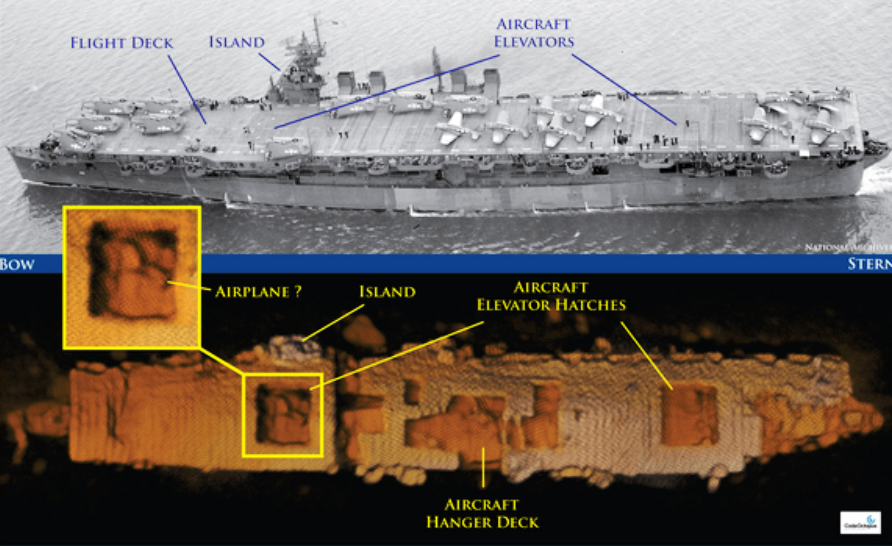|
The U.S.S. Independence, a WWII-era aircraft
carrier, has been discovered beneath 2,600 feet of water off the coast of the
Farallon Islands.

This image from NOAA depicts the Independence
as it appeared during its wartime service and a sonar image of the ship at rest
at the bottom of the Pacific Ocean, upright and mostly intact. (Courtesy NOAA)
HALF MOON BAY -- In a ghostly reminder of the Bay Area's nuclear heritage,
scientists announced Thursday they have captured the first clear images of a
radioactivity-polluted World War II aircraft carrier that rests on the ocean
floor 30 miles off the coast of Half Moon Bay.
The USS Independence saw combat at Wake Island and other decisive battles
against Japan in 1944 and 1945 and was later blasted with radiation in two South
Pacific nuclear tests. The Navy deliberately sunk the contaminated ship in 1951
south of the Farallon Islands.
The rediscovery of the USS Independence offers a fascinating glimpse into
American military history and raises old questions about the safety of the
Farallon Islands Radioactive Waste Dump -- a vast region overlapping what is now
a marine sanctuary where the federal government dumped nearly 48,000 barrels of
low-level radioactive waste between 1946 and 1970.
The expedition to locate and survey the Independence was led by the National
Oceanic and Atmospheric Administration, with help from the Navy and Boeing,
which mapped the wreck last month using a robotic underwater vehicle equipped
with cutting-edge sonar capable of producing three-dimensional images.
The images, which show the hull of the ship remains remarkably intact, suggest
the Independence lived up to its nickname, "The Mighty I."
The 623-foot-long ship took a remarkable degree of punishment over its 10-year
career, said NOAA official James Delgado, chief scientist of the Independence
mission. After World War II, the Independence was engulfed in a fireball and
heavily damaged during the 1946 nuclear weapons tests at Bikini Atoll,
transformed into a floating nuclear decontamination lab while stationed at
Hunters Point Naval Shipyard in San Francisco, then finally towed out to sea
laden with untold barrels of radioactive waste and scuttled with two torpedo
warheads.
The Independence was sunk on Jan. 26, 1951, and came to rest 2,600 feet below
the ocean surface.
The Navy withheld the location of the wreck for decades, but the U.S. Geological
Survey found its likely resting place while mapping the sea floor in 1990. In
2004, a NOAA ship captured a distant image of what looked like a giant
caterpillar stretched on the bottom of the ocean, said Delgado, who has led a
two-year mission to find and study historic shipwrecks in and around the Gulf of
the Farallones National Marine Sanctuary.
"This ship is an evocative artifact of the dawn of the atomic age, when we began
to learn the nature of the genie we'd uncorked from the bottle," said Delgado.
"It speaks to the 'Greatest Generation' -- people's fathers, grandfathers,
uncles and brothers who served on these ships, who flew off those decks and what
they did to turn the tide in the Pacific war."
Delgado said he doesn't know how many drums of radioactive material are buried
within the ship -- perhaps a few hundred. But he is doubtful that they pose any
health or environmental risk. The barrels were filled with concrete and sealed
in the ship's engine and boiler rooms, which were protected by thick walls of
steel, Delgado said.
The submarine that mapped the Independence got within 200 feet of the wreck, he
said. Scientists tested the vehicle and the water on its instruments for
radioactive isotopes and found only normal background radiation levels, he said.
But word of the Independence survey stirred up lingering concerns about the
nuclear waste near the Farallon Islands, an area teeming with wildlife. Retired
judge and state legislator Quentin Kopp, who many years ago demanded research
into the Navy's disposal of radioactive material off Northern California before
1970, said Thursday that the question of whether the waste posed a risk to
humans and wildlife was never resolved.
"If I were an elected legislator, state or federal, I would be pounding the
table," Kopp said.
Kai Vetter, a UC Berkeley nuclear engineering professor who assisted the survey,
said the ocean acts as a natural buffer against radiation. And the contaminated
sites are small enough that they wouldn't work their way into the broader food
chain, he added.
"The risk here to have a public health impact is extremely small," Vetter said.
Vetter said he hopes to obtain samples of the hull of the Independence in the
next year to analyze the effects of radiation and other forces on the metal.
Delgado said, however, there are no plans to further examine the wreck at this
time.
The Gulf of the Farallones sanctuary is a haven for wildlife, from white sharks
to elephant seals and whales, despite its history as a dumping ground.
Richard Charter, a senior fellow at the Ocean Foundation, was involved in the
creation of the sanctuary back in 1981. He said the radioactive waste is a relic
of a dark age before the environmental movement took hold.
"It's just one of those things that humans rather stupidly did in the past that
we can't retroactively fix," he said.
Article By Aaron Kinney |

